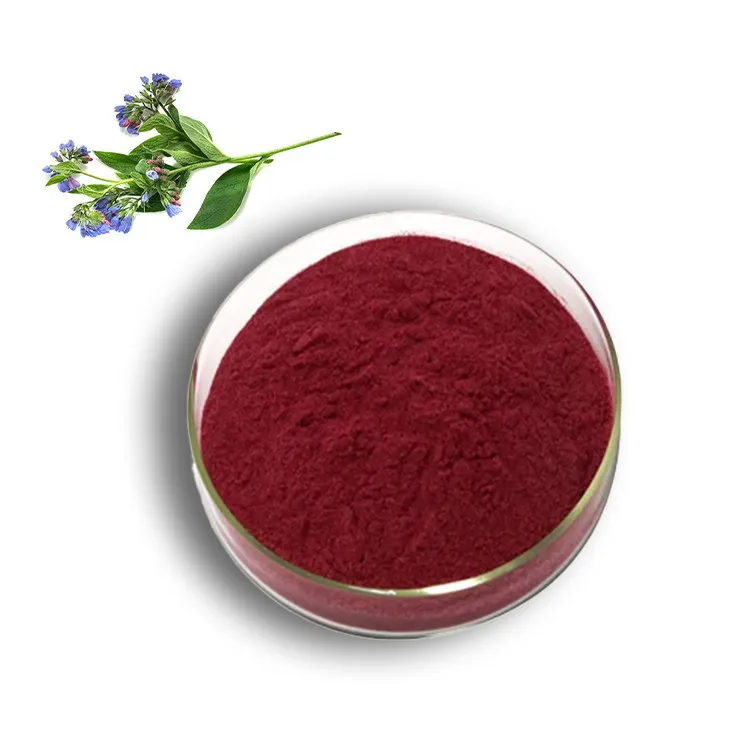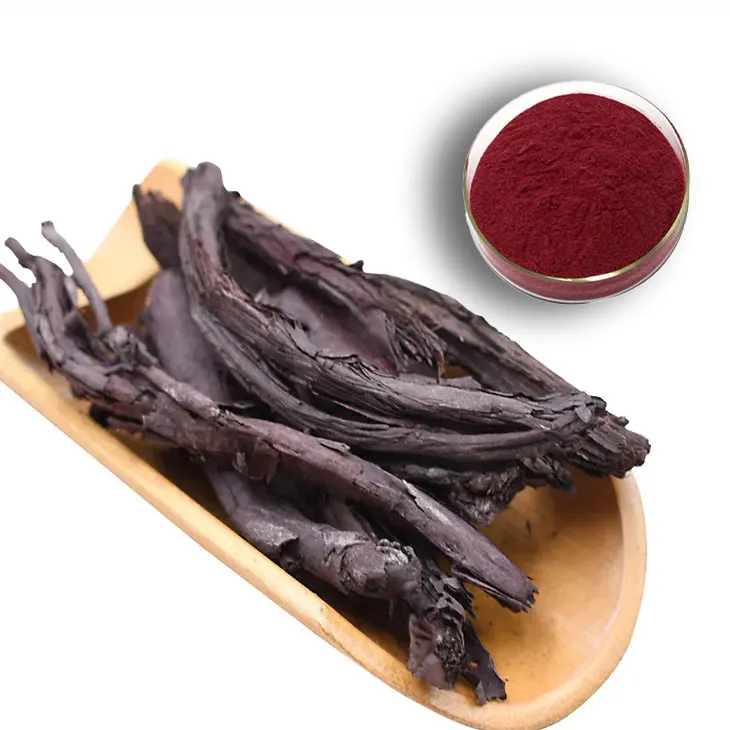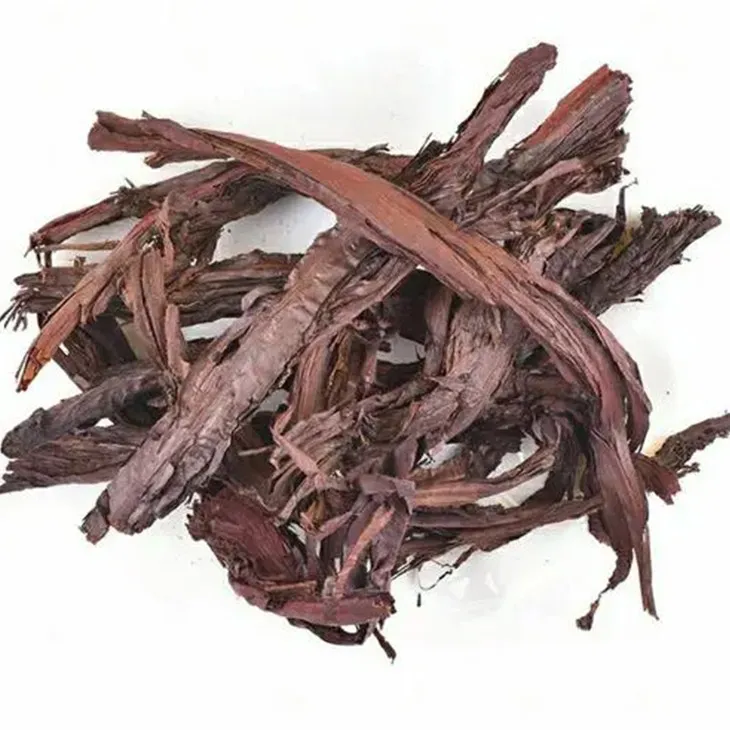- 0086-571-85302990
- sales@greenskybio.com
How to extract shikonin from plants?
2024-11-29

1. Introduction
Shikonin is a highly valuable natural compound that has found extensive applications in medicine, cosmetics, and other fields. It is primarily sourced from certain plants. The extraction of Shikonin from plants is a complex yet crucial process, which involves multiple steps and considerations. This article aims to provide a comprehensive guide on this extraction process.

2. Plant Selection
The first step in extracting Shikonin is the proper selection of plants. Lithospermum erythrorhizon is one of the most well - known plants that contain shikonin. However, other related plant species may also be potential sources.
When choosing plants for shikonin extraction, several factors need to be considered:
- Shikonin content: The plant should have a relatively high content of shikonin. This can be determined through preliminary analysis or by referring to existing research data.
- Availability: The plant should be readily available, either through cultivation or from natural sources. Cultivated plants may offer more consistent quality and quantity, while wild plants need to be harvested sustainably.
- Growth conditions: Plants grown in suitable environmental conditions are more likely to have a higher shikonin content. Factors such as soil type, sunlight exposure, and water availability can influence the biosynthesis of shikonin in plants.

3. Solvent Extraction
3.1. Principles
Solvent extraction is a commonly used method for shikonin extraction. The principle behind it is based on the solubility of shikonin in a particular solvent. Shikonin is a lipophilic compound, and solvents with suitable polarity can effectively dissolve it from the plant matrix.
3.2. Solvent Selection
The choice of solvent is crucial in solvent extraction. Organic solvents such as petroleum ether, ethyl acetate, and chloroform have been used for shikonin extraction.
- Petroleum ether: It has a relatively low polarity and can selectively extract shikonin while leaving behind some of the polar impurities. However, it is highly flammable and requires careful handling.
- Ethyl acetate: This solvent has a moderate polarity and is often preferred due to its relatively low toxicity compared to other solvents. It can extract shikonin effectively and is also easier to remove during the subsequent purification steps.
- Chloroform: Chloroform has good solubility for shikonin, but it is a toxic solvent. Its use needs to be strictly regulated, especially in applications where the final product is intended for use in cosmetics or medicine.
3.3. Extraction Procedure
The general procedure for solvent extraction of shikonin is as follows:
- Plant preparation: The selected plants are first dried and ground into a fine powder. This increases the surface area of the plant material, facilitating better solvent - plant interaction.
- Solvent addition: The powdered plant material is then mixed with the chosen solvent in a suitable ratio. For example, a common ratio could be 1:5 (plant material : solvent by weight). The mixture is placed in a flask or extraction vessel.
- Extraction: The extraction can be carried out through various methods, such as Soxhlet extraction or simple maceration. In Soxhlet extraction, the solvent is continuously recycled over the plant material, ensuring more complete extraction. Maceration involves simply soaking the plant material in the solvent for a certain period, usually several hours to days.
- Filtration: After the extraction is complete, the mixture is filtered to separate the solvent - containing shikonin from the plant residue. This can be done using filter paper or a filtration apparatus.
- Solvent evaporation: The filtrate, which contains the dissolved shikonin and the solvent, is then subjected to solvent evaporation. This can be achieved using techniques such as rotary evaporation under reduced pressure. The resulting residue is a crude shikonin extract.

4. Supercritical Fluid Extraction
4.1. Principles
Supercritical fluid extraction (SFE) is an advanced extraction method. A supercritical fluid is a substance that is above its critical temperature and critical pressure. Carbon dioxide (CO₂) is the most commonly used supercritical fluid for shikonin extraction. At supercritical conditions, CO₂ has properties between a gas and a liquid, which gives it excellent solvating power for shikonin.
4.2. Advantages
There are several advantages of using SFE for shikonin extraction:
- Environment - friendly: CO₂ is a non - toxic, non - flammable gas. After the extraction, it can be easily removed from the extract by simply reducing the pressure, leaving behind a relatively pure shikonin product. This reduces the environmental impact compared to traditional organic solvents.
- High selectivity: Supercritical CO₂ can be adjusted to have different solvating properties by changing the pressure and temperature. This allows for more selective extraction of shikonin, leaving behind unwanted impurities.
- Quality of the extract: The mild extraction conditions in SFE can help preserve the quality of shikonin. Since there is no need for high - temperature drying or the use of harsh solvents, the bioactivity of shikonin may be better maintained.
4.3. Extraction Procedure
The general steps for supercritical fluid extraction of shikonin are:
- Preparation of the plant material: Similar to solvent extraction, the plants are dried and ground into a fine powder.
- Loading into the extraction vessel: The powdered plant material is placed in the extraction vessel of the SFE equipment.
- Setting the extraction conditions: The temperature and pressure are set to the supercritical region for CO₂. Typically, the pressure may range from 10 - 50 MPa and the temperature from 35 - 60 °C, depending on the specific requirements for shikonin extraction.
- Extraction: Supercritical CO₂ is passed through the plant material in the extraction vessel. The shikonin is dissolved in the CO₂ and carried out of the vessel.
- Separation: The CO₂ - shikonin mixture is then passed through a separator where the pressure is reduced. This causes the CO₂ to return to its gaseous state, leaving behind the shikonin extract.
5. Factors Influencing Extraction Efficiency
5.1. Temperature
Temperature plays an important role in both solvent extraction and supercritical fluid extraction.
In solvent extraction, increasing the temperature can generally increase the solubility of shikonin in the solvent. However, if the temperature is too high, it may lead to the degradation of shikonin or the extraction of unwanted impurities. For example, when using ethyl acetate as a solvent, a temperature range of 30 - 50 °C may be optimal for shikonin extraction.
In supercritical fluid extraction with CO₂, the solvating power of CO₂ changes with temperature. Higher temperatures can increase the diffusivity of CO₂, but may also reduce its density and thus its solvating power for shikonin. A balance needs to be struck to achieve the best extraction efficiency.
5.2. Time
The extraction time also affects the extraction efficiency.
In solvent extraction methods like Soxhlet extraction or maceration, longer extraction times can lead to more complete extraction of shikonin. However, after a certain point, the increase in extraction yield may become marginal, and longer extraction times may also increase the extraction of impurities. For example, in Soxhlet extraction, extraction times ranging from 6 - 24 hours are commonly used, depending on the plant material and solvent.
In supercritical fluid extraction, the extraction time is also an important factor. Longer extraction times can increase the amount of shikonin extracted, but may also increase the energy consumption and cost of the process. Usually, extraction times of 1 - 3 hours are considered appropriate for shikonin extraction using supercritical CO₂.
5.3. Solvent Type
As mentioned earlier, the type of solvent used in solvent extraction has a significant impact on the extraction efficiency.
Different solvents have different polarities and solvating abilities for shikonin. The choice of solvent should be based on the chemical properties of shikonin and the nature of the plant matrix. For example, if the plant contains a large amount of polar compounds in addition to shikonin, a solvent with a moderate polarity like ethyl acetate may be more suitable as it can selectively extract shikonin while leaving behind some of the polar impurities.
6. Purification Steps
The crude shikonin extract obtained from either solvent extraction or supercritical fluid extraction usually contains impurities. Purification steps are essential to obtain high - quality shikonin for various applications.
6.1. Chromatography
Column chromatography is a commonly used method for purifying shikonin. A suitable stationary phase, such as silica gel, can be used. The crude extract is loaded onto the column, and different solvents or solvent mixtures are used as the mobile phase to elute the shikonin. Shikonin can be separated from other impurities based on its different affinities for the stationary and mobile phases.
6.2. Recrystallization
Recrystallization is another purification method. The crude shikonin extract is dissolved in a suitable solvent at an elevated temperature. Then, the solution is slowly cooled, allowing shikonin to crystallize out while leaving impurities in the solution. The choice of solvent for recrystallization is important. Solvents with a good solubility for shikonin at high temperatures but low solubility at low temperatures are preferred.
7. Conclusion
The extraction of shikonin from plants is a multi - faceted process that requires careful consideration of plant selection, extraction methods, factors influencing extraction efficiency, and purification steps. Solvent extraction and supercritical fluid extraction are two main extraction methods, each with its own advantages and limitations. By optimizing these processes and purification steps, it is possible to obtain high - quality shikonin for applications in medicine, cosmetics, and other fields, thereby fully exploiting the potential of this valuable natural compound.
FAQ:
What are the suitable plants for shikonin extraction?
Plants such as Lithospermum erythrorhizon are suitable for shikonin extraction. These plants are known to contain significant amounts of shikonin. However, different species within the Lithospermum genus may also be considered, depending on their availability and shikonin content.
How does solvent extraction work for shikonin?
In solvent extraction, a suitable solvent is chosen. Commonly, organic solvents like ethanol or methanol are used. The plant material is soaked in the solvent. Shikonin, being soluble in the solvent, gets dissolved. Then, through filtration and evaporation processes, the solvent is removed, leaving behind the shikonin extract. However, the choice of solvent affects the extraction efficiency and the quality of the final product.
What are the advantages of supercritical fluid extraction for shikonin?
Supercritical fluid extraction has several advantages. It uses supercritical fluids, often carbon dioxide, which has a low critical temperature and pressure. This method is more environmentally friendly compared to some traditional solvent extractions as it reduces the use of toxic solvents. It can also provide a higher purity of shikonin extract and has better selectivity, meaning it can target shikonin more precisely without extracting too many unwanted compounds.
How does temperature affect the extraction efficiency of shikonin?
Temperature plays a crucial role. Generally, increasing the temperature can enhance the solubility of shikonin in the solvent, which may lead to a higher extraction rate. However, if the temperature is too high, it can cause degradation of shikonin or extraction of unwanted compounds. Therefore, an optimal temperature range needs to be determined for each extraction method and plant material.
Why is purification important in shikonin extraction?
Purification is essential because the initial extract obtained from the plant may contain various impurities such as other plant metabolites, pigments, and residual solvents. These impurities can affect the quality and performance of shikonin in its applications. Purification steps, like chromatography, can remove these unwanted substances, ensuring that high - quality shikonin is obtained for use in medicine, cosmetics, etc.
Related literature
- Shikonin: A Review of Its Phytochemistry, Pharmacology, and Analytical Methods"
- "Extraction and Isolation of Shikonin from Lithospermum erythrorhizon: A Traditional Medicinal Plant"
- "Advances in Shikonin Extraction Technologies: A Comparative Study"
- ▶ Hesperidin
- ▶ citrus bioflavonoids
- ▶ plant extract
- ▶ lycopene
- ▶ Diosmin
- ▶ Grape seed extract
- ▶ Sea buckthorn Juice Powder
- ▶ Beetroot powder
- ▶ Hops Extract
- ▶ Artichoke Extract
- ▶ Reishi mushroom extract
- ▶ Astaxanthin
- ▶ Green Tea Extract
- ▶ Curcumin Extract
- ▶ Horse Chestnut Extract
- ▶ Other Problems
- ▶ Boswellia Serrata Extract
- ▶ Resveratrol Extract
- ▶ Marigold Extract
- ▶ Grape Leaf Extract
- ▶ blog3
- ▶ blog4
-
Nature's Bounty Almond Powder
2024-11-29
-
Organic Taurine Powder Suppliers.
2024-11-29
-
Bulk purchase of black pepper extract.
2024-11-29
-
Ginger extract of the best quality.
2024-11-29
-
Wholesale Passion Fruit Extract Suppliers.
2024-11-29
-
Organic Genistein, Australia.
2024-11-29
-
Sophora Japonica Flower Extract
2024-11-29
-
Beetroot juice Powder
2024-11-29
-
Marigold Extract
2024-11-29
-
Plantain extract
2024-11-29
-
Kelp Extract Powder
2024-11-29
-
Resveratrol extract
2024-11-29
-
Stevia Extract
2024-11-29
-
Artichoke Extract
2024-11-29
-
Horse Chestnut Extract
2024-11-29
-
Mango flavored powder
2024-11-29





















